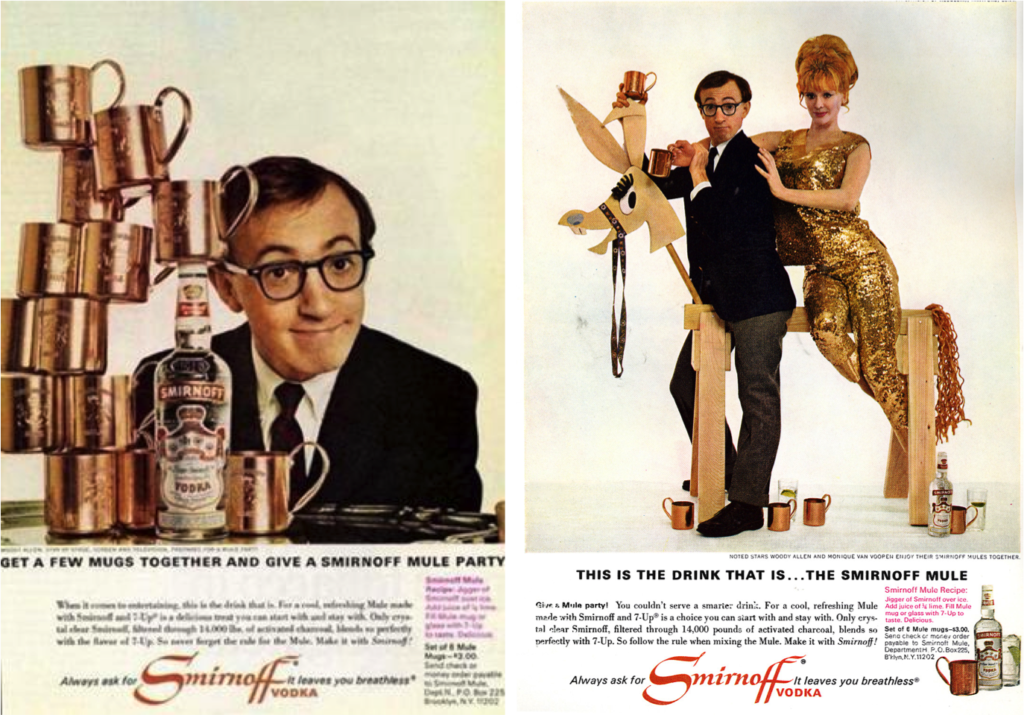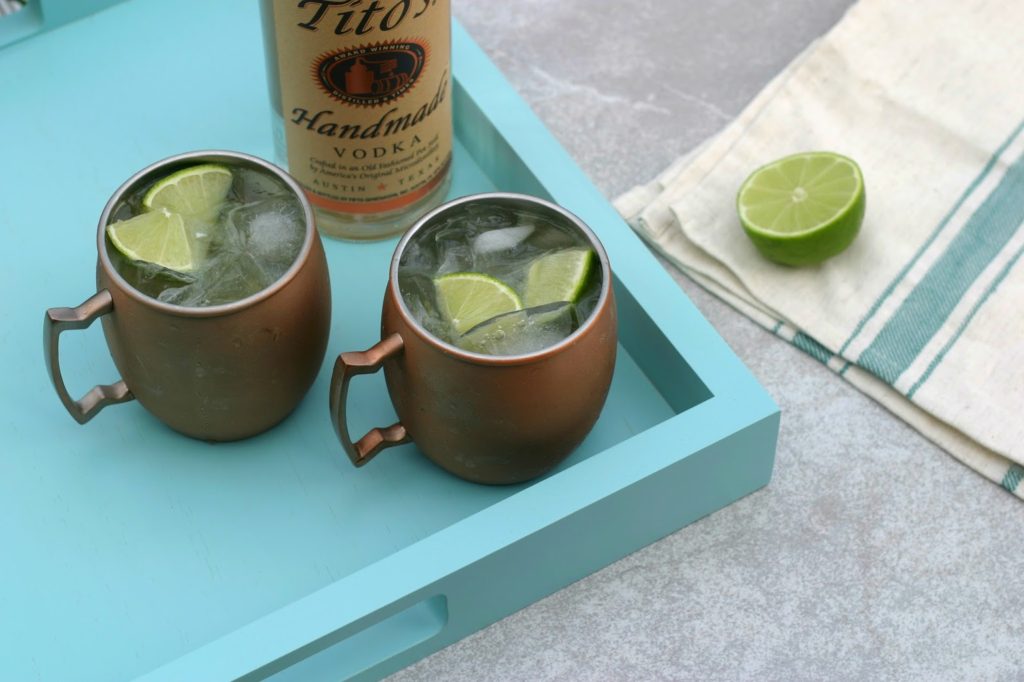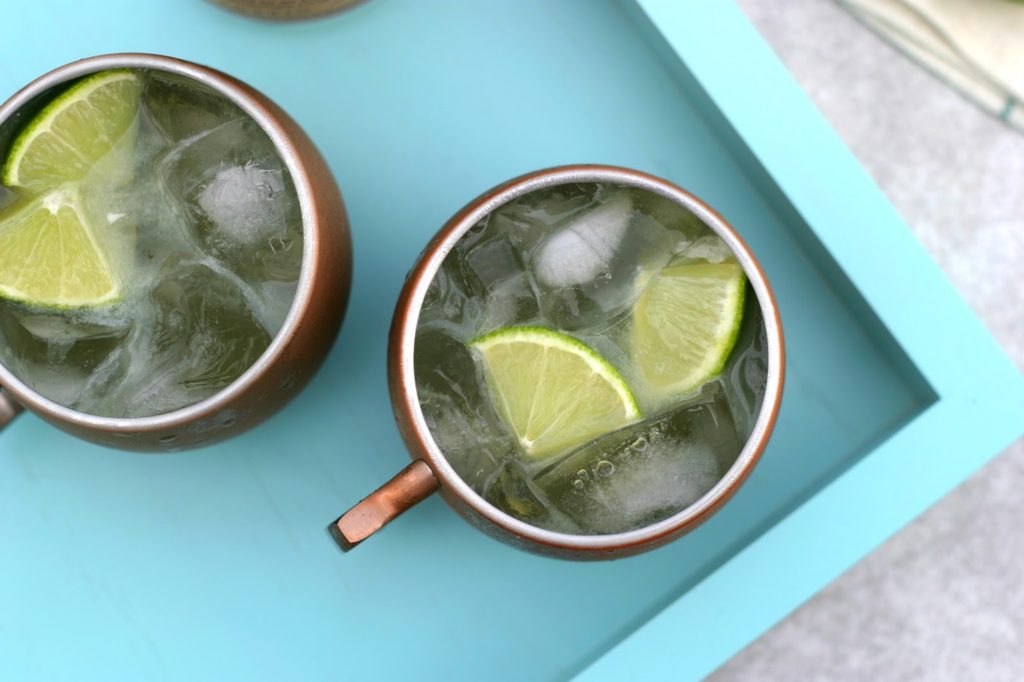I always thought the Moscow Mule was a below-average cocktail. I’ve already mentioned that I’m not really a fan of vodka, and mixing it with ginger beer basically just tastes like… ginger beer. The mere invention of the Moscow Mule was nothing more than a marketing trick to get people to buy vodka and ginger beer. (Seriously. Read on.) What makes this cocktail any better than a rum & Coke or bourbon & ginger? Does it really deserve its own fancy mug? And are you really going to make them often enough to justify buying a set?
Well, I’m not going to write off a cocktail until I’ve made it myself. Copper mug and all.
I was heartened when I found a recipe for the Moscow Mule in the PDT Cocktail Book. Not only did its inclusion in such a respected publication bring it up a few notches in my estimation, but the recipe was a little more involved than the vodka + ginger beer + wedge of lime I’d imagined. It uses lime juice, simple syrup, and a fairly low ratio of ginger beer to everything else. In fact, I thought it was too low and ended up adding more.
The finished product is not bad. I knew it would be tasty, but it’s also more sophisticated than I expected. I’ll always prefer spirits with more flavor, but I can appreciate the Moscow Mule as a decent vodka cocktail. It would be a great option for guests in the summer time.
And how did I, the Moscow Mule skeptic, end up with two copper mugs? They were a free gift from Redfin after we bought our condo, and if I turned them around you’d see the logo emblazoned on the back. I’m all about the free stuff.
Oh, and full disclosure: I had to double the recipe to fill them.
History: It was 1941, and Jack Morgan, the owner of the Cock ‘n Bull Restaurant in Hollywood, had a problem. He had recently started making his own brand of ginger beer, and no one was buying it. He shared his woes over a drink with two friends, John Martin and Rudolph Kunett, who worked for G. F. Heublein Brothers. They knew how he felt. Their company had recently started importing a Russian spirit called vodka, and the public wasn’t interested in drinking it. They suddenly realized the solution to both of their problems. What if they mixed the vodka and the ginger beer together and started serving it as a signature cocktail? They tried it right then and there, and were pleased with the results. They named the cocktail the Moscow Mule, Moscow for Russia, and Mule for… well, no one is really sure. The cocktail is technically a type of Buck. It may have been called a Mule because of its “kick.”
Martin traveled the country popularizing the drink, always in a copper mug so that everyone would know it was a Moscow Mule even in photographs. Why the copper mug? Well, apparently a Russian immigrant named Sophie Berezinski had designed the now-famous copper mug in her father’s shop back in Russia, and had come to the US with about 2,000 of them to sell. Only – you guessed it – no one wanted them. Martin clearly saw the commercial advantage of serving the Mule in signature mug. He made ads with celebrities drinking out them, and Morgan engraved the names of his celebrity patrons on mugs that he hung behind the bar at the Cock ‘n Bull. The cocktail’s popularity soared, as did that of its main ingredient, vodka.
 |
| Smirnoff ads from the 1960’s featuring Woody Allen, Monique Van Vooren, and the Moscow Mule. |
In a way, this is a disappointing origin story for a cocktail. It was entirely a commercial endeavor, invented to sell products, orchestrated right down to its serveware. But on the other hand, it’s kind of a great story. You can just picture the lightbulb going off in these guys’ heads as they realize what to do.
And, if I’m being honest, it’s really not a bad cocktail.
Moscow Mule
1 1/2 oz. vodka
3/4 oz. lime juice
3/4 oz. simple syrup
2 oz. ginger beer
Combine vodka, lime juice, and simple syrup in a shaker. Add ice and shake until chilled. Strain into a copper mug filled with ice. Top with ginger beer and stir gently. Garnish with a couple of lime wedges.
Recipe adapted from The PDT Cocktail Book.








